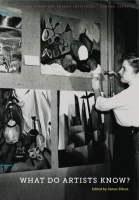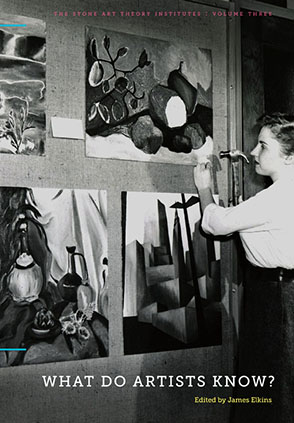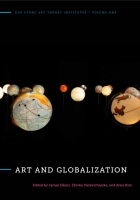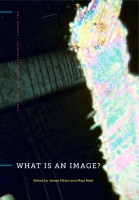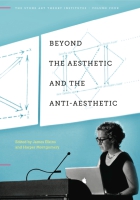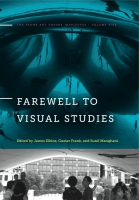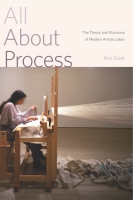What Do Artists Know?
Edited by James Elkins
Each of the five volumes in the Stone Art Theory Institutes series, and the seminars on which they are based, brings together a range of scholars who are not always directly familiar with one another’s work. The outcome of each of these convergences is an extensive and “unpredictable conversation” on knotty and provocative issues about art. This third volume in the series, What Do Artists Know?, is about the education of artists. The MFA degree is notoriously poorly conceptualized, and now it is giving way to the PhD in art practice. Meanwhile, conversations on freshman courses in studio art continue to be bogged down by conflicting agendas. This book is about the theories that underwrite art education at all levels, the pertinent history of art education, and the most promising current conceptualizations.
- Description
- Bio
- Table of Contents
- Sample Chapters
- Subjects
The contributors are Areti Adamopoulou, Glenn Adamson, Rina Arya, Louisa Avgita, Jan Baetens, Su Baker, Ciarín Benson, Andrew Blackley, Jeroen Boomgaard, Brad Buckley, William Conger, John Conomos, Christopher Csikszentmihályi, Anders Dahlgren, Jonathan Dronsfield, Marta Edling, Laurie Fendrich, Michael Fotiadis, Christopher Frayling, Miguel González Virgen, R.E.H. Gordon, Charles Green, Vanalyne Green, Barbara Jaffee, Tom McGuirk, William Marotti, Robert Nelson, Håkan Nilsson, Saul Ostrow, Daniel Palmer, Peter Plagens, Stephan Schmidt-Wulffen, Howard Singerman, Henk Slager, George Smith, Martin Søberg, Ann Sobiech Munson, Roy Sorensen, Bert Taken, Hilde Van Gelder, Frank Vigneron, Janneke Wesseling, Frances Whitehead, Gary Willis, and Yeung Yang.
James Elkins is E. C. Chadbourne Professor in the Department of Art History, Theory, and Criticism at the School of the Art Institute of Chicago. He coedited the previous volumes in the series, Art and Globalization (Penn State, 2010) and What Is an Image? (Penn State, 2011).
Contents
Series Preface
Introduction
James Elkins
The Seminars
1 Histories of Studio Art Teaching
2 What Parts of Those Histories Are Relevant?
3 The Possibility of a Book on Art Teaching Worldwide
4 Knowledge, Part 1
5 Knowledge, Part 2
6 The First-Year Program
7 The BFA Degree
8 The MFA Degree
9 The PhD Degree
Assessments
Areti Adamopoulou
Ciarín Benson
Andrew Blackley
Jan Baetens
Robert Nelson
Bert Taken and Jeroen Boomgaard
William Conger
Anders Dahlgren
Michael Fotiadis
Tom McGuirk
George Smith
Martin Søberg
Su Baker
Gary Willis
Yeung Yang
Louisa Avgita
Rina Arya
Brad Buckley and John Conomos
Charles Green
Hákan Nilsson
Laurie Fendrich and Peter Plagens
Janneke Wesseling
Vanalyne Green
Glenn Adamson
Henk Slager
Christopher Csikszentmihályi
Marta Edling
Sir Christopher Frayling
Miguel González Virgen
R.E.H. Gordon
Barbara Jaffee
William Marotti
Saul Ostrow
Daniel Palmer
Stephan Schmidt-Wulffen
Howard Singerman
Ann Sobiech Munson
Roy Sorenson
Hilde Van Gelder
Frank Vigneron
Frances Whitehead
Afterword
Howard Singerman
Notes on the Contributors
Index
Introduction
James Elkins
This introduction is adapted from the opening roundtable, September 21, 2009.
Welcome, everyone. This opening discussion is meant to be very informal: we’re just going to talk about some of the questions we hope to raise during the week of seminars. After today’s three-hour panel discussion, there will be twenty-seven hours of closed seminars, and then on Saturday the week will end with another public panel discussion. That one will be five hours long—yes, I know, five hours—but in the past it has been a great way to wrap up the week.
We have an outstanding Faculty here, and an equally amazing group of fifteen Fellows, from the U.S., Austria, the UK, Ireland, Belgium, Greece, Mexico, Hong Kong, Australia, Sweden, and Canada. Some are art historians who study the history of art instruction; some are philosophers; and others are experts in college-level art instruction, right up to the PhD. (And I wanted to record that we were going to have a Fellow from Iran, but the U.S. immigration people found out that she didn’t have a large bank account, and they decided that could only mean she was intending to settle here permanently.) We have all spent the last month reading. The Faculty assigned about fifteen hundred pages of texts, not including optional background reading on craft, design, and art education. There were also optional texts on related subjects such as contemporary art practices outside of academies.
So we are hoping to make some headway on some of the more difficult issues about how artists are taught, and what they know. This is an enormous field—actually, no one knows how big it is. The website artschools.com lists 2,055 art schools and departments in the U.S., so there must be at least five times that number in the whole world. Another site, gradschools.com, lists 486 MFA programs in the U.S. and Canada. Every year there are too many conferences, symposia, and lectures on this subject for anyone to attend. But at the same time, some of the most fundamental issues are completely unresolved. I was amazed, really amazed, when I discovered that there is basically no definition of the MFA. It is not an exaggeration to say no one knows what an MFA is, except in the trivial sense that it involves professional-level competence in visual art and that for the moment it’s still the terminal degree. No one has a good account of how art should be taught, why it should be taught, whether it should be taught, or even if it should be taught. No one knows what knowledge goes into art, or what knowledge comes out of it. And this goes doubly for the new PhD degree in studio art, which has raised some extremely difficult philosophic problems that no one, so far, as made much headway with. All this may sound improbable, but I don’t mind saying it—I just feel a bit more confident saying it now that I’ve read the fifteen hundred pages of texts for our seminars.
The first topic, the one that I think goes before all the others, is: What is the relevant history of art education? What historical periods, what institutions, are still relevant when we are thinking about how studio art is taught today? This may seem like a simple question, but there has not been much work on the subject, and even the basic outlines of the history of studio art instruction are open for discussion. Should we think of the French academy model as one coherent development? Or should we divide it into phases? Maybe it makes sense to distinguish five phases of academic art instruction in the West: the original Italian Accademia, the French academy and the proliferation of academies throughout Europe, the final phase of academies in the late nineteenth and early twentieth centuries, as they were swamped by Modernism, and finally the straggling survivors that continue to the present. It’s not that there isn’t scholarship on the history of academies: it’s that the scholarship is only historical, so it needs to be looked at again with an eye to what matters for the present.
Once that is decided, more or less, then it becomes possible to ask a second question: What practices, ideas, skills, techniques, and exercises are still relevant? In what specific ways is the Bauhaus still with us? What is currently done with Bauhaus exercises such as Joseph Albers’s color-sensitivity experiments, or the sequence from 2D to 4D, or the common first-year assignments where students gather objects of one color, or one texture, or one shape? What things have been introduced more recently—for instance, since the Second World War? And on the other hand, what remains from the Renaissance and Baroque academies? It is necessary to make a provisional inventory of these things, to compare it with what it taught today, and that’s because our current way of teaching art is a mixture, a collage of all sorts of different things from different times and places, and unless we begin to understand where the parts have come from, we won’t stand much of a chance of making sense of how art is taught.
We are also hoping to do some work on the very practical question of how art is currently taught around the world. That will be our third topic. It may sound unlikely, but actually very little is known about how art is taught worldwide. The major art schools in places like Los Angeles, London, New Haven, Helsinki, Maastricht, Frankfurt, Chicago, New York, and Berlin know one another, more or less, because they trade faculty and students, and because they are part of the international circuit of the art market. But there is no place to go to find out how art is taught in provincial China, India, or South America, or even how it varies from one state school to another in the U.S. The European Union has a major initiative called the Bologna Accords, which is engaged in comparing university departments and degrees across Europe. But outside Europe, there is no source, no central organization, and even within Europe there are any number of idiosyncratic institutions that fly below the Bologna radar. A few years ago I was in Bucharest, where I discovered the Academy there has a specialty in Romanian frescoes. You can go there to learn how to remove a fresco from the wall, and how to restore it, or how to paint a new one. But there are subtler differences everywhere. In Calgary, there is an emphasis on a particularly Canadian practice of painting, but also on conceptual art and postminimal sculpture. In Copenhagen, they read different art theory texts than in Stockholm . . . and so forth. Our third question is really just a forum: how can we gather information about how art is taught, so that the subject stops being such a black hole of endless anecdotal information?
The fourth subject for the week brings me to the question of the conference itself, What do artists know? I was surprised last year to discover that someone else at the School of the Art Institute had been working on that exact question. Frances Whitehead, who has co-organized this event with me, teaches in the Sculpture Department here at the School of the Art Institute, and she had been working on the question for several years. She hears the question very differently than I do. For me, it is about the ways art is taught all around the world, the histories of art instruction, and how to make sense of art instruction. In other words, the question is about what artists are taught, how they are taught, and why they are taught the things we teach them. For Frances, the question is about artists in the world, not necessarily in art schools at all. She wants to know, What do artists know that other people don’t? What kind of knowledge is particular to artists? How is it related to knowledge that other people have? And how do artists use their knowledge?
In the middle of the week, after we have discussed the history of art instruction and what elements of that history might be pertinent for the present, we will turn to Frances’s question about artistic knowledge. We’ll be considering texts by people who claim that artists have a special kind of knowledge called tacit knowledge, and arguments that artists’ knowledge has changed radically from what it had been in the past. It’s a wide-open field. In preparation for this event, I posted a couple of threads on Facebook, asking what artistic knowledge is. As you can imagine, the answers go across the whole spectrum from serious to completely goofy. Here are a couple, just to show the range:
One person said artistic knowledge is “skills” and “techniques.” I think we’d all agree, but we’d also hope it is much more than that.
Another said it is “intuition”: but what is that? And why don’t people who aren’t artists have intuition? Someone thought that artists work from a “different (more sensitized) position,” and others said it’s “personalized intelligence” or the capacity to work “at a heightened level”: but aren’t there callous artists? Impersonal artists? Stupid artists?
Another said it’s “genius”—but in the art world, we’re allergic to that idea.
Another person said what makes an artist is a “certain spiritual element”: I won’t go near that one.
A couple of people, more active in the art world, proposed that artistic knowledge is a matter of an “abstract, diffused, and communal practice” or that artists’ knowledge doesn’t matter because “perceived social value” is what counts.
And then there were the cynics (I imagine they all have MFAs). One said that artists know nothing, and that’s why they make art. Another said that there is no difference between artists and others because we all work for the same “entertainment industry.” And my favorite cynic wrote that artists only think they have knowledge, but really they just use their brains “in a strange way.”
So it went on Facebook. Here we’re intending to have a slightly more serious discussion, first about tacit knowledge and other new models, and then also about the philosophic tradition of claims about the knowledge that is contained in art. We have an expert on that subject, Roy Sorensen: he’s not an art world person; he’s an analytic philosopher, and he’s here to make sure our claims about knowledge in general make sense. He is going to present the arguments that have been made on behalf of what’s called aesthetic cognitivism: the claim that artworks can give us new knowledge, and that the knowledge they contain is integral to their value as artworks. It is a very difficult position to argue. What exactly do you learn, for example, from the Sistine Ceiling? (Other than Christian doctrine, which Michelangelo would assume you already knew.) What knowledge do you get from a Mondrian painting? The art world can be very loose and inexact in its claims, and we are hoping Roy will make sure we make some kind of sense. In the Seminars, we will divide the question, What do artists know? into two parts: Roy Sorensen’s philosophic introduction, which will be our fourth topic, and Frances Whitehead’s investigation into tacit knowledge, which will be our fifth topic.
Our remaining four topics are about individual degrees—the first year, the BA or BFA (outside the U.S., it’s usually the BA), the MFA or MA (again, outside the U.S. it’s usually the MA), several exotic degrees such as the MLitt and DLitt, and the very contentious PhD (which also exists as a DFA). What matters about these degrees is how people understand them. What should you expect, as a student, from a BFA? Why consider a PhD?
It’s the same here as it is with the first couple of topics to do with the history of art instruction. There is no lack of conferences where the different degrees are discussed, but they almost always get bogged down in personal, anecdotal, local information. People speak about their own programs, and what they have put in place. On the other hand, there is an administrative literature on the different degrees, and there are professional associations that monitor and accredit the degrees, so we will be considering their literature as well as the local and anecdotal texts. Our aim is to ask how the different degrees are conceptualized. What are the best available models for what happens in the first year? What are the best accounts of what the BFA should be? What are the most convincing theories about what the MFA does? And what are the most interesting ways to think about the studio art PhD? All those are our sixth, seventh, eighth, and ninth topics: the first- year program, the BFA, the MFA, and the PhD.
Perhaps it’s hopeless to try to make headway on such an enormous subject. Stephan Schmidt-Wulffen, one of our Faculty, said he “desperately hopes” the week doesn’t “end in despair.” Let’s see how it goes.
Also of Interest
Mailing List
Subscribe to our mailing list and be notified about new titles, journals and catalogs.
